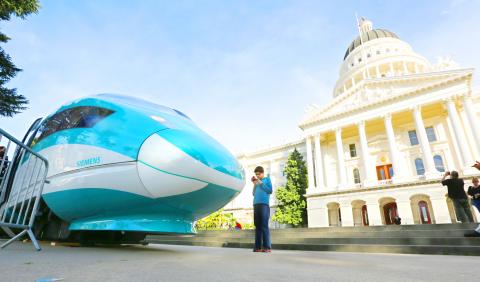Travelers easily whiz from city to city on high-speed trains in many parts of South America, Asia and Europe. Since the first high-speed lines began operating more than 50 years ago in Japan, they have become an essential part of transportation worldwide.
Yet the US has never built a single stretch of high-speed rail, which is generally defined as accommodating trains that go at least 321kph and proposals to do so have been thwarted for decades.
So what is holding the US back?

Photo: AP
For starters, a much larger land mass, longer distances between major cities and the high cost of construction. Other factors include efficient air travel, relatively low prices for gasoline and a car-based culture.
“The challenge in America is the scale of America,” said Robert Eckels, chief executive of the Texas Central High Speed Railway, a private venture that is planning a bullet train between Dallas and Houston, Texas.
In recent decades, political pressure against bullet trains has come from conservatives, who argue that such systems should acquire private financial backing and prove that their operations will at a minimum be cost-neutral. It is a burden state and federal governments do not place on other huge transportation projects, such as freeways and airports.
For now, the best the country can do is Amtrak’s Acela, which reaches speeds of up to 240kph on a busy route between Washington and Boston.
In an effort to jump-start high-speed rail, the administration of US President Barack Obama in 2009 awarded US$7 billion for projects in California, Florida and Wisconsin. Republican governors in Florida and Wisconsin rejected the funding and backed out of high-speed rail plans, sending more of those dollars to California.
The list of other proposals for faster-speed rail includes: linking Las Vegas with greater Los Angeles; Chicago with St Louis; Harrisburg, Pennsylvania, with Pittsburgh; Oklahoma City with Tulsa; and upgrading track on a medium-speed line between Miami and Orlando.
Despite the political resistance and financial hurdles, two projects have moved beyond the conceptual phase. One is California’s US$68 billion plan for a high-speed rail network connecting northern and southern California. The other is the privately financed plan in central Texas.
California’s long-term financing plan relies heavily on federal money that is unlikely to materialize in a Republican-controlled US Congress, but Democratic Governor Jerry Brown remains a strong supporter, negotiating a dedicated funding stream through a separate program that raises money from businesses as part of an effort to reduce greenhouse gas emissions.
The Texas project has received much less publicity than California’s, yet it could become the nation’s first operating bullet train line.
Private-public partnerships in construction may be the best way to mute political criticism, as well as kick-start the projects, said Andrew Goetz, a professor and faculty associate who studies high-speed rail at the Intermodal Transportation Institute at the University of Denver.
Rail proponents argue that the lack of high-speed rail has hurt US competitiveness. The typical US business traveler spends two days of travel to attend one meeting, said Andy Kunz, president and chief executive of the US High Speed Rail Association.
“We’re stuck in traffic for hours. We’re dealing with horrible airlines as it deteriorates,” Kunz said. “The whole country is getting shortchanged by this.”

The US dollar was trading at NT$29.7 at 10am today on the Taipei Foreign Exchange, as the New Taiwan dollar gained NT$1.364 from the previous close last week. The NT dollar continued to rise today, after surging 3.07 percent on Friday. After opening at NT$30.91, the NT dollar gained more than NT$1 in just 15 minutes, briefly passing the NT$30 mark. Before the US Department of the Treasury's semi-annual currency report came out, expectations that the NT dollar would keep rising were already building. The NT dollar on Friday closed at NT$31.064, up by NT$0.953 — a 3.07 percent single-day gain. Today,

‘SHORT TERM’: The local currency would likely remain strong in the near term, driven by anticipated US trade pressure, capital inflows and expectations of a US Fed rate cut The US dollar is expected to fall below NT$30 in the near term, as traders anticipate increased pressure from Washington for Taiwan to allow the New Taiwan dollar to appreciate, Cathay United Bank (國泰世華銀行) chief economist Lin Chi-chao (林啟超) said. Following a sharp drop in the greenback against the NT dollar on Friday, Lin told the Central News Agency that the local currency is likely to remain strong in the short term, driven in part by market psychology surrounding anticipated US policy pressure. On Friday, the US dollar fell NT$0.953, or 3.07 percent, closing at NT$31.064 — its lowest level since Jan.

The New Taiwan dollar and Taiwanese stocks surged on signs that trade tensions between the world’s top two economies might start easing and as US tech earnings boosted the outlook of the nation’s semiconductor exports. The NT dollar strengthened as much as 3.8 percent versus the US dollar to 30.815, the biggest intraday gain since January 2011, closing at NT$31.064. The benchmark TAIEX jumped 2.73 percent to outperform the region’s equity gauges. Outlook for global trade improved after China said it is assessing possible trade talks with the US, providing a boost for the nation’s currency and shares. As the NT dollar

The Financial Supervisory Commission (FSC) yesterday met with some of the nation’s largest insurance companies as a skyrocketing New Taiwan dollar piles pressure on their hundreds of billions of dollars in US bond investments. The commission has asked some life insurance firms, among the biggest Asian holders of US debt, to discuss how the rapidly strengthening NT dollar has impacted their operations, people familiar with the matter said. The meeting took place as the NT dollar jumped as much as 5 percent yesterday, its biggest intraday gain in more than three decades. The local currency surged as exporters rushed to